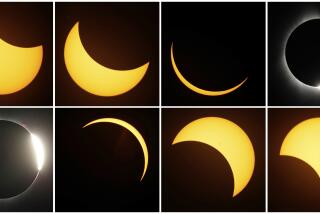New NASA satellite to study why the sun is so, you know, hot
IRIS, as NASA’s newest scientific satellite is known, will launch into space Thursday at 7:27 p.m. Pacific, and you can watch it leave the planet live, right here on latimes.com.
The satellite the size of a motorcycle is being sent to space to help scientists solve a longstanding solar mystery: Why is the sun’s upper atmosphere so much hotter than the sun’s surface?
The hottest temperatures of the sun are found at its core, where a fusion reaction continuously turns hydrogen atoms into helium atoms. There, at the center of the sun, the temperature is millions of degrees Fahrenheit.
The energy generated at the core gradually moves through the various layers of the sun, eventually leaking out to the surface, where the temperature is about 10,000 degrees Fahrenheit.
Watch the IRIS launch live, beginning 6 p.m. Thursday
That makes sense -- temperatures usually drop as you move away from a heat source.
But then things take an unexpected turn. The temperature of the sun’s upper atmosphere, called the corona, is several million degrees.
To explain this sudden jump in temperature, scientists have concluded that something in the region between the sun’s surface and the corona, a thin area called the transitional region, is causing the corona to get superheated, but they are not yet sure what.
Some scientists theorize that magnetic fields with roots in the sun’s surface get so twisted in the interface region that they eventually snap like rubber bands and release vast stores of energy that heat the corona. Others suggest that energy jets that originate deep within the sun and travel through the transitional region are responsible. Still more say that powerful acoustic waves might be the cause.
But to know for sure, scientists need to get a very good look at the transitional region itself, said Pete Worden, the Center Director of NASA’s Ames Research Center, and a Co-Investigator for the IRIS mission.
That’s where IRIS comes in. The light emitted by the transitional region is in an ultraviolet range that is filtered out by the Earth’s atmosphere, so it impossible to study this region with ground-based telescopes.
But the soon-to-be space-based IRIS is equipped with a powerful ultraviolet telescope that will snap images of this mysterious and violent region every two seconds in unprecedented detail and hopefully reveal some of its secrets.
IRIS is currently scheduled for a two year mission, but could continue collecting data on this poorly understood region of the sun for much longer, said Worden. He added that it would take IRIS about one month once it has been launched into space to start sending data back to Earth.
To learn more about the science of the IRIS mission, see the video below.
ALSO:
Watch 3 years of solar activity in a 3-minute video
New crypt-keeping beetle species discovered on Pacific island
Planets survived birth in harsh, stormy star cluster, study says







